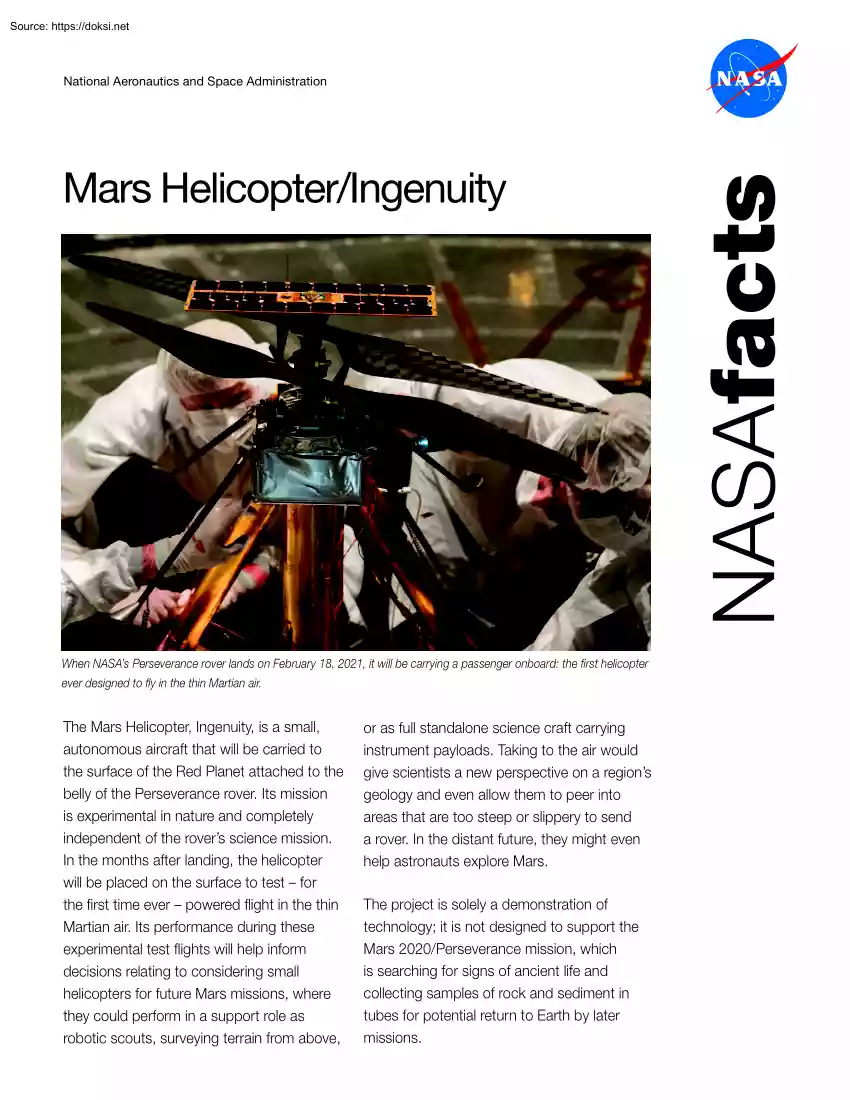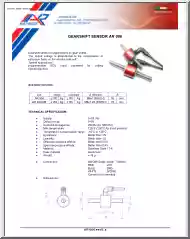Please log in to read this in our online viewer!

Please log in to read this in our online viewer!
No comments yet. You can be the first!
What did others read after this?
Content extract
National Aeronautics and Space Administration Mars Helicopter/Ingenuity When NASA’s Perseverance rover lands on February 18, 2021, it will be carrying a passenger onboard: the first helicopter ever designed to fly in the thin Martian air. The Mars Helicopter, Ingenuity, is a small, autonomous aircraft that will be carried to the surface of the Red Planet attached to the belly of the Perseverance rover. Its mission is experimental in nature and completely independent of the rover’s science mission. In the months after landing, the helicopter will be placed on the surface to test – for the first time ever – powered flight in the thin Martian air. Its performance during these experimental test flights will help inform decisions relating to considering small helicopters for future Mars missions, where they could perform in a support role as robotic scouts, surveying terrain from above, or as full standalone science craft carrying instrument payloads. Taking to the air would
give scientists a new perspective on a region’s geology and even allow them to peer into areas that are too steep or slippery to send a rover. In the distant future, they might even help astronauts explore Mars. The project is solely a demonstration of technology; it is not designed to support the Mars 2020/Perseverance mission, which is searching for signs of ancient life and collecting samples of rock and sediment in tubes for potential return to Earth by later missions. This illustration shows the Mars Helicopter Ingenuity on the surface of Mars. Key Objectives Key Features • • • • • • • • Prove powered flight in the thin atmosphere of Mars. The Red Planet has lower gravity (about onethird that of Earth) but its atmosphere is just 1% as thick, making it much harder to generate lift. Demonstrate miniaturized flying technology. That requires shrinking down onboard computers, electronics and other parts so that the helicopter is light enough to take off.
Operate autonomously. Ingenuity will use solar power to charge its batteries and rely on internal heaters to maintain operational temperatures during the cold Martian nights. After receiving commands from Earth relayed through the rover, each test flight is performed without real-time input from Mars Helicopter mission controllers. Dimensions • • Height: about 19 inches (0.49 meters) Rotor system span: about 4 feet (1.2 meters) National Aeronautics and Space Administration Jet Propulsion Laboratory California Institute of Technology Pasadena, California www.nasagov JPL 400-1715 Rev. 1 4/20 Weighs 4 pounds (1.8 kg) Solar-powered and recharges on its own Wireless communication system Counter-rotating blades spin about 2,400 rpm Equipped with computers, navigation sensors, and two cameras (one color and one black-and-white) Program Management The Mars 2020 Project and Mars Helicopter Technology Demonstration are managed for NASA’s Science Mission Directorate, Washington, by
the Jet Propulsion Laboratory (JPL), a division of Caltech in Southern California. At NASA Headquarters, David Lavery is the program executive for the Mars Helicopter. At JPL, MiMi Aung is the Mars Helicopter project manager and J. (Bob) Balaram is chief engineer. For more information about the Mars Helicopter and NASA’s Mars Exploration Program, visit: mars.nasagov/technology/helicopter NASA Facts
give scientists a new perspective on a region’s geology and even allow them to peer into areas that are too steep or slippery to send a rover. In the distant future, they might even help astronauts explore Mars. The project is solely a demonstration of technology; it is not designed to support the Mars 2020/Perseverance mission, which is searching for signs of ancient life and collecting samples of rock and sediment in tubes for potential return to Earth by later missions. This illustration shows the Mars Helicopter Ingenuity on the surface of Mars. Key Objectives Key Features • • • • • • • • Prove powered flight in the thin atmosphere of Mars. The Red Planet has lower gravity (about onethird that of Earth) but its atmosphere is just 1% as thick, making it much harder to generate lift. Demonstrate miniaturized flying technology. That requires shrinking down onboard computers, electronics and other parts so that the helicopter is light enough to take off.
Operate autonomously. Ingenuity will use solar power to charge its batteries and rely on internal heaters to maintain operational temperatures during the cold Martian nights. After receiving commands from Earth relayed through the rover, each test flight is performed without real-time input from Mars Helicopter mission controllers. Dimensions • • Height: about 19 inches (0.49 meters) Rotor system span: about 4 feet (1.2 meters) National Aeronautics and Space Administration Jet Propulsion Laboratory California Institute of Technology Pasadena, California www.nasagov JPL 400-1715 Rev. 1 4/20 Weighs 4 pounds (1.8 kg) Solar-powered and recharges on its own Wireless communication system Counter-rotating blades spin about 2,400 rpm Equipped with computers, navigation sensors, and two cameras (one color and one black-and-white) Program Management The Mars 2020 Project and Mars Helicopter Technology Demonstration are managed for NASA’s Science Mission Directorate, Washington, by
the Jet Propulsion Laboratory (JPL), a division of Caltech in Southern California. At NASA Headquarters, David Lavery is the program executive for the Mars Helicopter. At JPL, MiMi Aung is the Mars Helicopter project manager and J. (Bob) Balaram is chief engineer. For more information about the Mars Helicopter and NASA’s Mars Exploration Program, visit: mars.nasagov/technology/helicopter NASA Facts




